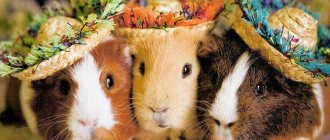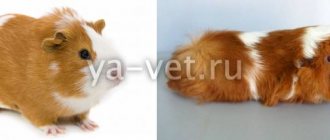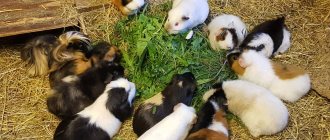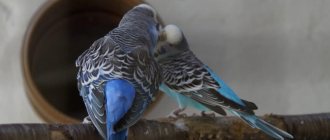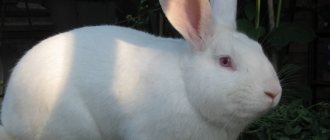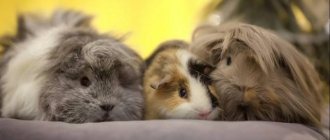Just 20 years ago, not all parents had the opportunity to give their child a dream - a puppy or a kitten. And this is not surprising - such animals had to be walked with, they required a lot of attention, and animals that could be kept in a cage were, in general, very rare on the open market. Modern children are luckier. Many hobbyists breed and sell various small animals. For example, breeding guinea pigs as a business has become a very popular idea. Moreover, children really like these funny animals, and this, you see, is a good reason to become interested in this business idea. Therefore, now we will talk about how to implement it and start earning good money.
Readiness to breed
Females are ready to breed much earlier than males. They reach sexual maturity at the age of six to eight weeks. Boys are ready to mate no earlier than the twelfth week of life. However, breeders who have been breeding animals for many years do not recommend mating such young pigs. The female’s body is not yet fully strengthened and early pregnancy can result in the birth of still cubs, babies with various physical disabilities, and even the death of a female guinea pig. The recommended age for the first mating is no earlier than 10-11 months.
Determining the sex of animals
How to distinguish a male from a female guinea pig is a rather difficult question, especially when it comes to young animals and an inexperienced breeder. However, this point is important both for breeding and when purchasing mammals. Usually boys are larger than girls, but this only applies to babies of the same litter. In the store, animals can be of different ages, fatness, and the larger animal may well be a girl. You can tell more accurately whether it is a boy or a girl by examining the genitals, or more precisely, the anus. How to determine:
- you need to take the animal with your left hand and turn it belly up,
- The palm of the other hand should clasp the pig in the lumbar region,
- With your thumbs, gently press on the bottom of the animal’s tummy above the genitals.
When pressed, the penis is felt in boys, and the genital slit in girls.
Correct determination of sex will help to separate the cubs from their mother into cages and avoid unwanted close crossing and many other problems.
Some breeders claim that with constant observation of young animals, behavioral differences between the sexes can be noticed. Boys have a more active and playful character, and are sometimes pugnacious. Girls are calmer. Females and males can also be distinguished by their voice. Guinea pigs are very sociable animals and make a lot of sounds. The voice of females is usually thinner and quieter.
How to choose a pair
Successful breeding of guinea pigs, especially for business purposes, requires the correct selection of producers. A boy and a girl must not only be strong and healthy, in good shape, but also have other important qualities:
- correct body structure,
- correct exterior
- sufficient fatness,
- quality wool,
- friendly character,
- absence of bad habits.
The breeder should remember that not only positive, but also negative traits of their parents are passed on to guinea pig cubs. When choosing young animals, preference should be given to cubs born in the summer from dairy and large mothers.
Guinea pigs mating
It is recommended to mate each female guinea pig no more than twice a year. Constant pregnancy and frequent childbirth lead to complete exhaustion of the body, shortened life expectancy, the birth of weak or dead babies, and even death. Males must also have their own mating schedule. Guinea pig sperm may lose motility and become unable to fertilize an egg. Not only the number of partners affects the success of mating, but also the fatness of the male.
Obesity, like underweight, leads to decreased reproductive function.
If the conditions are good, then the females are ready to breed 12 months a year. Estrus in guinea pigs occurs every 13 to 18 days and lasts two days, but the most favorable period for fertilization is the first few hours. Many inexperienced breeders wonder how to find out whether a guinea pig is pregnant or not. The answer is very simple - if the next heat does not occur, then the pig is pregnant. Estrus is very easy to notice - the female changes her behavior. She begins to pose in front of the male, crouches and freezes in front of him, spreading her hind legs and raising her butt.
Guinea pigs mate several times a day. If the female is kept separately, then for mating she is placed in a cage with the male every three to four hours. This method also has a small disadvantage - you can miss the onset of estrus, which means the chance of successfully mating the animals is noticeably reduced.
Breeding pigs at home
Breeding guinea pigs at home For the process to be successful, some features must be taken into account.
Those who do not plan to breed guinea pigs should immediately take into account when getting a male and a female that the only methods of contraception for these animals are sterilization and castration. The non-invasive method is separate cells.
Sexual cycle and sexual maturity
The recommended age for the first mating is no earlier than 10-11 months. Sexual maturity in females occurs earlier than in males. They have been producing offspring for one and a half to two months.
Males begin breeding at 12 weeks. However, it is not advisable to breed such young animals. Their offspring will be weak and non-viable. Also, the animals themselves can quickly die from exhaustion of the body if bred so early. The correct age for guinea pigs to give birth to their first babies is 10 months.
You cannot produce offspring from a guinea pig more than twice a year. This will weaken the animal’s body too much and it will get sick. Estrus in females occurs once every 14-18 days. It lasts up to two days, and more often – 24-30 hours. The favorable period for mating is the first 6 hours of estrus. If fertilization is successful, then the next estrus will not occur.
It is not difficult to notice that a pig is in heat. Her behavior immediately changes. She flirts with the male. Freezes in front of him, crouching, raising his butt and spreading his paws.
Pair selection
Successful breeding of guinea pigs is only possible if the right pair is selected. When deciding on individuals for reproduction, consider the following:
- compliance with the exterior;
- absence of defects in the structure;
- condition of the animal;
- friendliness towards relatives.
When breeding, you can not only mate existing animals, but also pay for matings with breeding males who have won exhibitions.
The cost of such a service can vary greatly (from 100 to 1000 rubles) depending on the awards the animal has and the rarity of the breed to which the manufacturer belongs.
The use of mating with elite males is justified if it is planned to create a nursery for breeding guinea pigs and it is necessary to obtain high-quality stock for the parent stock.
How to find out the gender of a guinea pig?
Pairing
It is recommended to mate pets no more than twice a year. Mating occurs several times a day. As soon as the female's heat ends, the male will lose interest in her.
A week before mating, animals are transferred to a light diet enriched with vitamin E. It is advisable to keep the male and female separately for 2-3 days before mating. This improves sperm quality and increases the likelihood of fertilization.
When guinea pigs are kept using the harem method, there is no need to separate the males from the females. However, in such a situation, it is impossible to allow more than two compacted pregnancies in a row. They greatly deplete the female’s body, and then without a rest break it will not be possible to obtain high-quality offspring.
It is necessary to separate the male from the female after mating only if he shows an aggressive attitude towards her. After the birth of the cubs, the male must be removed without fail.
The guinea pig will be ready for the next mating within 14 hours after birth, and a new pregnancy is extremely undesirable for it. Also, a male left in one cage can kill the offspring.
Pregnancy and childbirth
After 3-4 weeks, pregnancy is determined by feeling the abdomen.
Pregnancy in a guinea pig lasts from 60 to 72 two days, depending on the number of cubs, which ranges from 2 to 4. If no complications arise, the birth is easy and the female does not require assistance. In case of complications during the birth of offspring, the help of a veterinarian will be required.
Couple or family
Guinea pigs can be bred monogamously or in a harem way. With the monogamous method, a male and a female are selected. Such a pair will eventually become inseparable, but this does not mean that the female will not have to be separated from the male. The first reason why a female may need a separate cage is the boy’s aggressiveness towards newborn cubs. The second is re-fertilization. Immediately after giving birth, the female is ready for re-coating, but this will cause irreparable harm to her health and affect the amount of milk and her attitude towards the offspring.
If you plan to breed guinea pigs as a business, then you should resort to harem housing.
In this case, there are up to ten females per male. The harem method is more effective because it allows you to get more offspring. The downside is that several separate cages are required for pregnant females. The entire harem can be kept in one cage, but its size must be really large. If the family consists of one male and five females, then the cage must be at least two meters long, at least 75 cm wide, and have two tiers, each 40 cm high. The number of houses should be equal to the number of females. With this method of keeping, females can feed and care for all children, without dividing them into their own and others.
Features of pregnancy, childbirth and the postpartum period
Guinea pig pregnancy lasts from 60 to 72 days. The exact duration of pregnancy depends on how many cubs a guinea pig carries, as well as its breed and health. A multiple pregnancy ends earlier, but the birth of one or two babies can only occur on days 70–72. You can find out how many babies a pig will have already in the third week of pregnancy. By carefully palpating the pig's tummy, you can feel small dense nodules - embryos. Usually childbirth lasts no more than an hour and the animal does not require additional assistance.
The female gives birth in a sitting position, quickly ruptures the amniotic membrane and carefully licks the newborn. However, if the female has 8 - 10 cubs, labor can last much longer. Newborn guinea pigs are already fully formed and ready for life: their eyes are open, they have all their teeth, they quickly stand on their feet and within a few hours are running around the cage. Baby guinea pigs are able to taste adult food already on the third day from their birth, but still they will not survive without their mother’s milk. Rest is very important for a pregnant guinea pig. That is why there must be a house in the cage. You should feed your guinea pig three or four times a day.
A good alternative to drinking water during this period can be tomato juice or rosehip decoction.
In the first time after childbirth, she also needs increased nutrition. Fresh greens and hay should be available at all times. It is recommended to feed more food containing vitamin E (succulent plant foods, sprouted oats, barley or wheat), vitamin C (carrots and fruits), and calcium.
Childbirth
Lack of appetite and increased thirst indicate that labor is approaching. The process of birth of cubs takes no more than one and a half hours. There are from 1 to 5 piglets in a litter, each of which emerges at intervals of 10-15 minutes. After the guinea pig gives birth, it independently ruptures the amniotic sac, gnaws the umbilical cord and licks the babies.
Attention! Guinea pigs are born with a body covered in fur. Their eyes are open and their teeth are formed.
Newborn babies do not need anything; their mother takes care of them. The main thing is not to touch the babies with your hands, otherwise the female will refuse them due to the foreign smell.
Home business
With the right approach, breeding guinea pigs can become a good business. More than three million of these cute and funny animals are sold in Russia every year. The initial costs of purchasing even a very thoroughbred pair and cage will quickly be recouped from the sale of the offspring. Each female brings from one to six cubs, but it is not uncommon for a litter of up to ten babies.
However, before starting breeding, the breeder needs to establish good connections with pet stores or find potential clients on forums.
The success of selling young animals completely depends on this. It is also worth remembering that pigs of rare breeds and colors not only cost more, but also sell faster. Another business idea is breeding pigs for meat. It is not so popular in Russia, but if desired, you can find restaurants in large cities that want to get the tasty dietary meat of this animal.
Source
Selection by breed
The number of animal breeds and different variations of their colors cannot be counted. Sometimes new species appear by chance. But it is unlikely that it will be possible to breed a new variety at home - this requires obtaining at least ten animals with securely fixed characteristic features of the new breed.
Experienced breeders breed predominantly purebred animals, that is, from generation to generation, crossing representatives of the same breed, and not allowing the inclusion of other varieties.
Crossing pets with long and short hair is not encouraged - such a union will produce mixed-breed babies. Their appearance will be interesting, but such animals will not be able to participate in exhibitions or continue the family line.
To breed breeding pets, it is prohibited to bring together motley animals. Such offspring only slows down the development of the breed. Therefore, when choosing a partner for your pet, you should consider only animals of either the same breed or varieties that are acceptable for crossing.
Breeding at home
Breeding and keeping guinea pigs at home is not as difficult as it might seem at first glance. The sexual cycle in females repeats every two weeks.
You cannot uncontrollably mate a male and a female - no more than 2-3 times a year. At one time, a female can give birth to up to 8 cubs.
To breed guinea pigs at home, just one pair is enough, after a while this pair becomes inseparable. However, the male must be transferred to a separate cage during the period when the female is pregnant and after giving birth.
Features of keeping and caring for guinea pigs
As noted above, guinea pigs are very unpretentious in maintenance and care. But, it very often happens that, having decided to start breeding these cute animals, a novice breeder finds himself alone with guinea pigs, and does not know at all how to care for them at home, how to arrange a corner for keeping them. Therefore, now we will try to briefly talk about this.
Premises requirements
To keep guinea pigs you need to prepare the space:
- Well lit;
- Well ventilated;
- With a constant air temperature of 18-20⁰С (in the case of hairless breeds, the temperature may be higher);
- Moderate air humidity from 50 to 55%.
When preparing the premises, we must not forget that guinea pigs do not tolerate drafts, direct sunlight, or overheating. Therefore, the cages should be placed so that they are as far as possible from windows and heating devices.
Cells
Since guinea pigs are very mobile, to keep them you will need spacious housing with dimensions of at least 40x40 centimeters and always made of metal, for example, nickel-plated. After all, animals are characterized by abundant urination, and wood tends to quickly absorb moisture, which is not very good in terms of hygiene. Well, a metal house:
- Durable;
- Well ventilated;
- It is easy to disinfect;
- It will withstand the strong teeth of pigs.
Under the cages there must be trays where you can lay natural material that absorbs moisture well (sawdust pressed with granules, crushed corn stalks, large sawdust). This bedding is changed once a week. At exactly the same frequency, the cage and equipment are washed and disinfected, except for the place where the pigs go to the toilet (this area is cleaned every day, pouring fresh litter there, and if there is a special tray there, it is washed).
Accessories
When asking how to keep a guinea pig at home, it is very important to remember the minimum set of accessories for cages and, of course, their quality. The cells must contain:
- Bowls for food and drinking water (it is recommended to purchase dishes so that they can be secured without leaving the animals the opportunity to turn them over), which need to be washed and filled daily;
- Houses for sleeping and relaxation;
- Stone for grinding teeth.
Well, to make it more interesting for the pigs to move around, the living space needs to be equipped with different shelves, little pots, ladders and, of course, wooden toys and twigs for gnawing.
Matching
Whether the breeding of pigs will be successful and whether such a business can bring income to breeders depends on how well the pair is selected. When choosing, you need to consider the following:
- Animal color.
- Health status.
- The structure of the body (it must be correct).
- Character (the rodent must be friendly and not show aggression).
During the breeding period, animals can be mated not only with their mate, but also with a pig that takes winning places at exhibitions. The cost of this service is not very high - 100-1000 rubles, depending on pedigree, prizes and awards. The benefit of this service is that in this way you can get high-quality livestock.
Pair selection
The success of pig breeding largely depends on the correct formation of a pair of animals. Determining the right breeds is half the battle. It is equally important to choose the right specific partner.
Pigs forming a pair must be approximately the same age and not closely related. Among the mandatory requirements for future parents are also:
- good character;
- healthy body;
- fatness;
- good physical condition;
- absence of hereditary diseases.
For example, for mating you cannot take an animal that has ever had problems with teeth - the offspring will inherit bad teeth.
Particular attention should be paid to the color of the animals. Rodents of some colors cannot be crossed with each other - these are roan-colored animals, as well as Dalmatians. When crossing dark guinea pigs with each other, a lethal gene is formed - the offspring will not be viable. Even if some babies manage to survive, they will receive abnormalities that will make their existence a real torment - blindness, deafness, deformation of body parts or internal organs, etc.
As for diseases that are not inherited, the animal should not participate in mating until the disease is completely cured. You should also not mate your pet immediately after healing. From the moment the animal fully recovers, you need to wait some time and only after that bring it together with a partner.
In order for healthy babies to be born, future parents should not be skinny or, on the contrary, overfed. The best weight is considered to be 700–1000 g for both mother and father (the minimum acceptable is 500 g).
Pets that are too slender may have problems with pregnancy and delivery, which can lead to the death of both the babies and the mother herself. Well-fed animals may have difficulties with fertilization and also childbirth. Overly plump animals are recommended to be put on a diet and to increase the amount of activity and walks. When the pet loses excess weight, it can be allowed to mate.
Pregnancy and childbirth
Pregnancy in female guinea pigs lasts 60-70 days. Its presence can be determined already in the second or third week after its onset. To do this, lightly press on the female’s abdomen and count the number of embryos. Shortly before giving birth, the female begins to build a nest for the babies.
There should always be water at room temperature in the drinking bowl; a few days before giving birth, the female may experience extreme thirst. The water temperature should not exceed 18-20°. During this period, it is also useful to give the guinea pig fresh milk, tomato juice, and rosehip decoction. A pregnant female needs peace and rest, so it is necessary to make a separate house for her, in which she could retire if necessary.
The expectant mother should be fed at least four times a day.
Childbirth in a guinea pig usually takes place without complications; the female copes quite well on her own and does not require any additional help. In most cases, one hour is enough for childbirth. If any complications arise, you should immediately call a veterinarian.
A female guinea pig needs to eat intensively not only during pregnancy, but also for some time after giving birth. To provide enhanced nutrition, foods such as fresh greens, hay, carrots, oats, wheat, barley, and fruits are suitable. In addition, the pig needs to be given calcium, which can be used both in liquid form and in the form of pre-crushed tablets.
Guinea pig cubs are born fully developed - their eyes are already fully open, they have teeth, and their body is covered with hair, and after a few hours they begin to move freely around the cage, and after a few days they begin to try adult food. However, babies should be fed with mother's milk, as it contains all the vitamins and minerals they need. They simply won't survive without it.
Baby pigs should not be touched with hands in the first few days after they are born, otherwise the mother will not feed them milk. For 2-3 weeks, babies are fed breast milk, and then gradually become accustomed to adult food.
During pregnancy and after birth, the male should be kept in a separate cage. If he is in the same cage with the babies and the female who has just given birth, he will not cause any harm to the cubs. But the female can immediately become pregnant again - she is ready for mating less than a day after the children are born. True, it is impossible to allow her to become pregnant again in such a short period of time, due to her body being weakened by childbirth and due to the fact that milk may disappear during pregnancy.
For business
Breeding guinea pigs for the purpose of profit from their sale is quite a profitable and uncomplicated business. To breed a large number of rodents, it is necessary to create a nursery, which should contain only elite breeds of pigs. It is desirable to have a pedigree and victories at various exhibition events.
You need to start with preparing all the necessary documents, since the breeder must register his business with the relevant authorities. Such a business is registered as a limited liability company or individual entrepreneurship. When the issue with the documents is settled, the issue with the place of breeding should be resolved. From the equipment for breeding pigs you will need:
- feeders and drinkers;
- cells;
- straw and sawdust;
- dry food.
When purchasing animals, you must ensure that they are all healthy and of good pedigree, vaccinated with all necessary vaccinations, including rabies. In addition, it is important that the female and male are not related to each other.
It is better to use the “harem” method of breeding guinea pigs - in this case there are several females per male. The entire population can live in one large cage, but for pregnant females it will be necessary to purchase separate smaller cages.
Profitability
Guinea pigs are very prolific rodents, so all breeding costs will more than pay off for the breeder in a fairly short time. At one time, on average, you can get 5-6 cubs from one female. You can start selling rodents at the age of 2-3 weeks. The cost of one guinea pig is $40, but this is if the parents of the cubs are not an elite breed. From prize-winners with elite pedigrees you can get up to $500 for one individual. It turns out that from one birth of an ordinary guinea pig you can get $200-240. For guinea pig breeding to be a profitable business, there must be at least 50 animals. Thus, the income received can be $12,000.
When making a profit, you should deduct from it the costs of food, veterinarian, cages, bedding, as well as taxes and utility bills. At the very beginning, this amount also includes inventory and equipment purchased for business development. The amount that remains in the end is pure profit; in most cases, a guinea pig breeder can recoup half of the money spent by selling the animals.
National dish of Peru
Baked or fried guinea pig is a national treat in Peru. The dish is called “kui”. It is prepared on holidays, for guests or just as part of a regular dinner. It all depends on the side dish and sauces served. Before cooking a guinea pig, the animal's carcass is thoroughly washed, rubbed with spices and left in a cool place for an hour or two.
To prepare you need:
- animal carcass,
- About one hundred grams of corn or regular flour,
- One onion, preferably red,
- One tomato
- A couple of potatoes
- A teaspoon of cumin,
- Salt with black pepper,
- A little sunflower oil
- Hot chili or chili sauce,
- Medium lemon
- Two liters of water.
Mix flour with salt (half a teaspoon). Dissolve one tablespoon of salt and lemon juice in cold water. The guinea pig, previously sprinkled with pepper and salt, is placed in the marinade for another couple of hours. After the required period of time, the carcass is removed from the marinade, washed, sprinkled with black pepper and cumin, salted and breaded in flour. Heat the oil in a frying pan, put the guinea pig carcass in it, close the lid on top (preferably under pressure) and fry until a golden, even crust forms. In the same oil, fry chopped potatoes with onion rings. The finished guinea pig is served with chili, sprinkled with finely chopped onion and tomato, and with potatoes. For taste, you can sprinkle the meat with lemon juice.
Difficulties and pitfalls
When deciding to breed guinea pigs, it is important to consider some sensitive issues that any breeder may face.
- Purchasing purebred guinea pigs is the most pressing problem that an amateur breeder may face.
- When guinea pigs are kept in large numbers in one cage, there is a risk of contracting infectious diseases. In this case, all individuals die, even vaccinated ones.
- Sometimes, after giving birth, a female may lose her maternal instinct due to stress and anxiety, as a result of which she herself can pass on her offspring. If this happens, it is advisable for this female not to happen to anyone and never again.
- Due to a stressful situation, the female may also lose milk, as a result of which there is a need to artificially feed the baby guinea pigs.
- Another important problem when breeding guinea pigs can be the birth of dead fetuses. Possible reasons are insufficient care of the animal during pregnancy, the presence of any infection in the pet.
- When selling guinea pigs, it is important to cover a large area where there are potential buyers. Otherwise, there will be serious financial risks.
Breeding guinea pigs for sale is a profitable and profitable business. But only if all the necessary conditions are met, and the parents of the pigs are an elite breed. It is difficult to realize outbred offspring. It is important to take this into account when starting a business.
Source
Postpartum care
Immediately after giving birth, the female needs proper feeding. At this time, she constantly needs fresh grass and hay. When it comes to feed, emphasis should be placed on those rich in vitamins E and C, calcium (sprouted grains and vegetables).
The female, for whom this is the first birth, may refuse to feed the offspring. For 6–8 hours, the animal owner should not show concern; the babies will be fine.
If after the specified time the mother still does not deign to feed the cubs, the following procedure should be carried out: isolate the pig with the offspring in a small box, protected from light. Usually this measure leads to the fact that after half an hour maternal instincts wake up.
It happens that a female’s nipples become inflamed during lactation. In this case, you need to treat them with chamomile decoction or a weak solution of potassium permanganate. You should examine your nipples regularly, as if inflammation is not noticed in time, it can result in mastitis.
In this case, the milk becomes thick and yellowish in color. The female may develop a fever and refuse to eat. Mastitis is treated by expressing milk, thus performing a massage of the mammary glands.
If the owner of the animal, carrying out this procedure daily, does not notice an improvement in the condition, you need to contact a specialist.
Often after giving birth, the animal goes bald, this should not frighten you: the hair will grow back after 15–20 days. Otherwise, you should contact your veterinarian. If there are ulcers on the bald patches, they are treated with a weak pink solution of potassium permanganate.
If the offspring turns out to be large, one of the babies will definitely be deprived of mother's milk. The weakest individuals will be malnourished - those who weigh less, they need to be fed. Such nutrition is carried out with infant formulas that do not contain lactose.
Using a syringe (without a needle), 3 mg of the mixture is injected through the nasal openings three times a day.
For 12–15 days after birth, babies should not be picked up unless absolutely necessary. If there is such a need, wash your hands thoroughly before contact.
Did you know? Guinea pigs were domesticated approximately 7 thousand years ago by Indians living in the Andes, but exclusively for food consumption.
